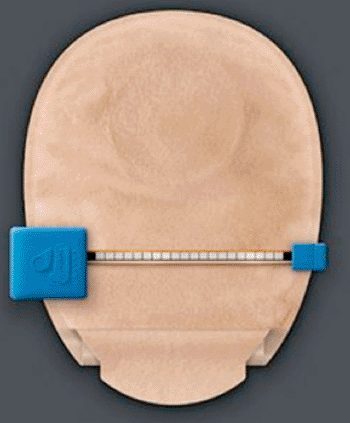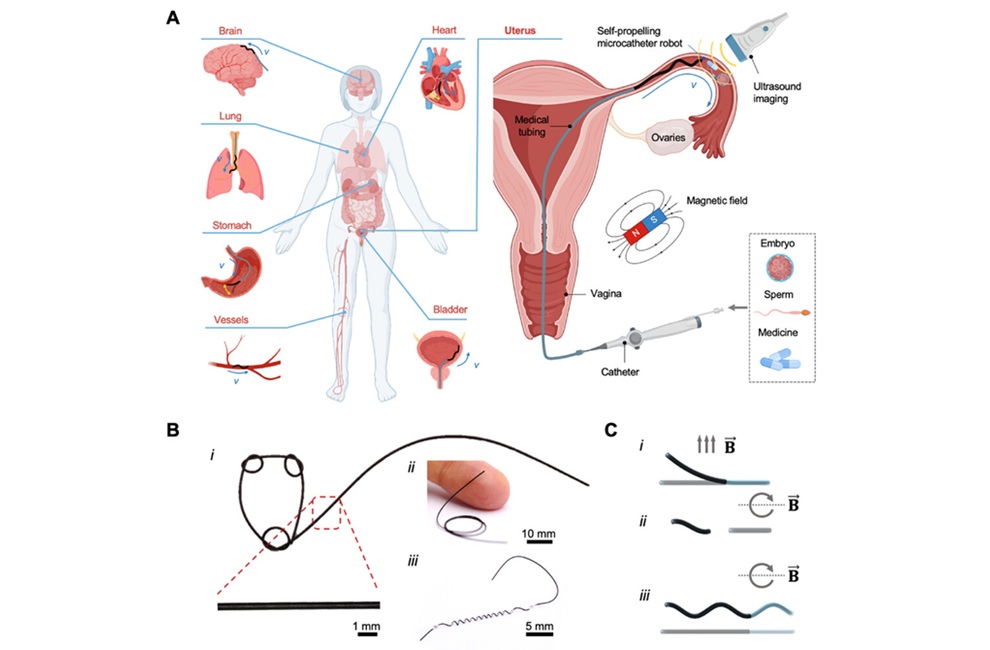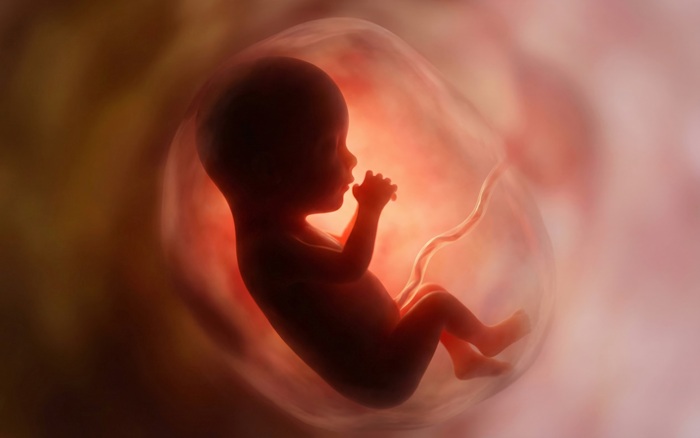Sensor Alerts Patients to Empty Ostomy Bags
|
By HospiMedica International staff writers Posted on 11 Dec 2013 |

Image: The Ostom-i Alert device (Photo courtesy of 11 Health).
A novel sensor-based device warns patients when their ostomy bags are full, so that they can empty them without risking an overflow.
The Ostom-i Alert device is single use device that attaches to any ostomy bag and can be used for up to three months. The sensor accurately measures pouch fullness by sensing the arc of the bag’s external curvature, sending messages via Bluetooth to a mobile app that warns the patient when the bags is close to being full. The sensor can also track the volume of output over a particular period, with the information transmitted through email to the patient or caregiver. Volume output data is also available on the company’s website and accessible to the patient through a secure login.
The device allows the user to alter alarm limits via the app, depending on the users’ body position over an extended period. For instance, when the patient is lying down, the ostomy bag may appear to be less full than it is when the patient is standing up. By setting alarm limits to a lower level, unwanted overflows and leaks causing embarrassment to the patient and caregivers can be avoided. The Ostom-i Alert is a product of 11 Health (London, United Kingdom), and has been approved by the US Food and Drug Administration (FDA).
“This device will automate a report for your physician,” said Michael Seres, inventor of the Ostom-I, and founder and CEO of 11 Health. “You’d know in advance if you could empty it without any problems; alerts can be set for any time, including notifying the user if the bag is filling up overnight. Just leave your mobile phone by the bed and set an alarm.”
An ostomy bag is prosthetic device for the collecting waste output from a stoma created during colostomies, ileostomies, and urostomies. The bags allow the stoma to drain into a sealed collection pouch via a baseplate, while protecting the surrounding skin. For maximum hygiene and to reduce risk of infection via contamination, the bag should be changed every 24 hours, unless the bags are resealable. Ostomy bags are air- and water-tight, allowing the wearer to lead an active lifestyle.
Related Links:
11 Health
The Ostom-i Alert device is single use device that attaches to any ostomy bag and can be used for up to three months. The sensor accurately measures pouch fullness by sensing the arc of the bag’s external curvature, sending messages via Bluetooth to a mobile app that warns the patient when the bags is close to being full. The sensor can also track the volume of output over a particular period, with the information transmitted through email to the patient or caregiver. Volume output data is also available on the company’s website and accessible to the patient through a secure login.
The device allows the user to alter alarm limits via the app, depending on the users’ body position over an extended period. For instance, when the patient is lying down, the ostomy bag may appear to be less full than it is when the patient is standing up. By setting alarm limits to a lower level, unwanted overflows and leaks causing embarrassment to the patient and caregivers can be avoided. The Ostom-i Alert is a product of 11 Health (London, United Kingdom), and has been approved by the US Food and Drug Administration (FDA).
“This device will automate a report for your physician,” said Michael Seres, inventor of the Ostom-I, and founder and CEO of 11 Health. “You’d know in advance if you could empty it without any problems; alerts can be set for any time, including notifying the user if the bag is filling up overnight. Just leave your mobile phone by the bed and set an alarm.”
An ostomy bag is prosthetic device for the collecting waste output from a stoma created during colostomies, ileostomies, and urostomies. The bags allow the stoma to drain into a sealed collection pouch via a baseplate, while protecting the surrounding skin. For maximum hygiene and to reduce risk of infection via contamination, the bag should be changed every 24 hours, unless the bags are resealable. Ostomy bags are air- and water-tight, allowing the wearer to lead an active lifestyle.
Related Links:
11 Health
Latest Patient Care News
- Revolutionary Automatic IV-Line Flushing Device to Enhance Infusion Care
- VR Training Tool Combats Contamination of Portable Medical Equipment
- Portable Biosensor Platform to Reduce Hospital-Acquired Infections
- First-Of-Its-Kind Portable Germicidal Light Technology Disinfects High-Touch Clinical Surfaces in Seconds
- Surgical Capacity Optimization Solution Helps Hospitals Boost OR Utilization

- Game-Changing Innovation in Surgical Instrument Sterilization Significantly Improves OR Throughput
- Next Gen ICU Bed to Help Address Complex Critical Care Needs
- Groundbreaking AI-Powered UV-C Disinfection Technology Redefines Infection Control Landscape
- Clean Hospitals Can Reduce Antibiotic Resistance, Save Lives
- Smart Hospital Beds Improve Accuracy of Medical Diagnosis
- New Fast Endoscope Drying System Improves Productivity and Traceability
- World’s First Automated Endoscope Cleaner Fights Antimicrobial Resistance
- Portable High-Capacity Digital Stretcher Scales Provide Precision Weighing for Patients in ER
- Portable Clinical Scale with Remote Indicator Allows for Flexible Patient Weighing Use
- Innovative and Highly Customizable Medical Carts Offer Unlimited Configuration Possibilities
- Biomolecular Wound Healing Film Adheres to Sensitive Tissue and Releases Active Ingredients
Channels
Critical Care
view channel
Bioadhesive Strategy Prevents Fibrosis Around Device Implants on Peripheral Nerves
Peripheral nerves connect the brain and spinal cord to muscles, organs, and sensory systems, making them key targets for treating neurological and systemic diseases. However, implantable bioelectronic... Read more
Miniature Non-Invasive Robotic Catheters to Improve Infertility Treatments
Minimally invasive procedures in reproductive and gynaecological medicine are often limited by the difficulty of navigating narrow, delicate anatomical pathways without damaging surrounding tissue.... Read moreSurgical Techniques
view channel
Catheter-Based Procedures Offer Less Invasive Option for Treatment of Valvular Disease
Valvular heart disease, caused by tight or leaky valves between heart chambers, affects up to 10% of older adults and leads to more than 120,000 deaths globally each year. Traditional open-heart surgery... Read moreLaparoscopic Surgery Improves Outcomes for Severe Newborn Liver Disease
Biliary atresia is a rare but life-threatening liver condition in newborns that blocks bile flow and leads to progressive liver damage if not treated early. Surgery is typically performed within the first... Read moreHealth IT
view channel
EMR-Based Tool Predicts Graft Failure After Kidney Transplant
Kidney transplantation offers patients with end-stage kidney disease longer survival and better quality of life than dialysis, yet graft failure remains a major challenge. Although a successful transplant... Read more
Printable Molecule-Selective Nanoparticles Enable Mass Production of Wearable Biosensors
The future of medicine is likely to focus on the personalization of healthcare—understanding exactly what an individual requires and delivering the appropriate combination of nutrients, metabolites, and... Read moreBusiness
view channel
Philips and Masimo Partner to Advance Patient Monitoring Measurement Technologies
Royal Philips (Amsterdam, Netherlands) and Masimo (Irvine, California, USA) have renewed their multi-year strategic collaboration, combining Philips’ expertise in patient monitoring with Masimo’s noninvasive... Read more
B. Braun Acquires Digital Microsurgery Company True Digital Surgery
The high-end microsurgery market in neurosurgery, spine, and ENT is undergoing a significant transformation. Traditional analog microscopes are giving way to digital exoscopes, which provide improved visualization,... Read more
CMEF 2025 to Promote Holistic and High-Quality Development of Medical and Health Industry
The 92nd China International Medical Equipment Fair (CMEF 2025) Autumn Exhibition is scheduled to be held from September 26 to 29 at the China Import and Export Fair Complex (Canton Fair Complex) in Guangzhou.... Read more
















